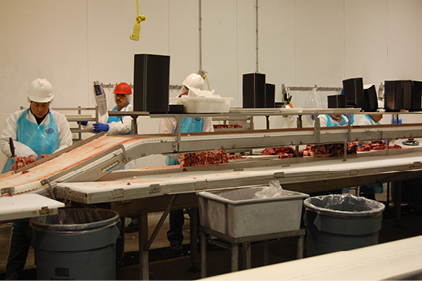Conveyors are the arteries and veins of a plant which serpentine through rooms, transporting products between processing and packaging lines and into waiting trucks. The implementation of conveyors has dramatically improved the means in which product is transported. Totes, tubs, carts and lugers have been replaced by these simple yet critical pieces of equipment.
Conveyor designs have gone from a tubular, bulky frame with cloth or neoprene belts to an open, elegant design with myriad foodgrade belts for various applications. As conveyors are added to production floors, different styles, types and the ever-popular recycled ones from the boneyard are used. This mixture of conveyors increases the complexity of safety, quality and maintenance as well as parts inventory by having to carry non-standard items.
Although conveyors may seem to be a simple piece of equipment to design; balancing safety, food safety and functionality is challenging. As you read further, there are designs and guides which will allow one to meet the desired results of safety, quality and functionality for conveyors.
Design
Properly designed, installed and maintained conveyors improve efficiencies and minimize non- value added labor. But, just as plaque can build in one’s vascular system, poorly designed and built conveyors can constrict and block the movement of product, thus reducing efficiencies and profitability.
“But it is just a conveyor. How can a simple conveyor affect safety, quality and efficiencies?” The answer is simple and starts with the design of the conveyor, its components and belting. This in turn leads to the cleanability and maintenance of the conveyor directly impacting food safety and quality.
Design of conveyors must incorporate safety, cleanability and maintenance, not only functionality. As designs have improved, one can clearly see where these aspects are not independent. When a conveyor’s parts are easily accessible, maintenance and cleanability are simplified.
Break down a conveyor to its components; frame, bearings, sprockets, drive motor, belt and a design would seem simple. Yet go into any plant and you will likely see a cornucopia of conveyor styles; tubular frames, angled frames and some cobbled up frames from boneyard remnants. The frames have had a number of welding jobs performed on them, reflecting the scars of a hard life as a conveyor. To avoid the ‘platypus conveyor’, simply follow and apply the AMI Guidelines for Sanitary Design of Equipment to conveyors, and your plant’s lifelines can be kept healthy and efficient.
- AMI Sanitary Design Principles
- Cleanable to a Microbiological Level
- Made of Compatible Materials
- Accessible for Inspection, Maintenance, Cleaning & Sanitation
- No Product or Liquid Collection
- Hollow areas Hermetically Sealed
- No Niches
- Sanitary Operational Performance
- Hygienic design of maintenance enclosures
- Hygienic Compatibility with Other Plant Systems
- Validate Cleaning & Sanitizing Protocols
Components
For example, bearings (properly sized) need to be installed with threaded stand-offs to insure proper cleaning as well as longer wear. Instead of holes drilled in the side, which can wear, or lead to misalignment, shaft and belt movement, threaded stand-offs are needed. Mounting the bearing off the frame eliminates areas for harborage of product and niches while improving accessibility for inspection. From a maintenance point, removing a bolt from the threaded off-set is easier than a bolt with washers and a nut.
The frame should be channel, angle or flat; no tube or enclosed structure. Of course the type of product being conveyed will dictate the needed structural requirements.
An open design with minimum required cross-bracing will allow the cleaning medium as well as scrub pads to contact these surfaces much better. Several conveyor manufacturers have unique designs that not only provide durable structural frames but address the maintenance and sanitary design principles.
Safety
Another aspect of the design must incorporate guarding and the safety of the operator(s) and those working on the cleaning of its components.
Addressing nip points, keyways, motor mounts and kill switches should meet all ANSI and OSHA standards. Older designed conveyors normally have to be retrofitted to eliminate nip points and areas where new regulations have been adopted to improve safety.
Although open designs provide greater access to cleaning, access to nip points and pinch points can be increased. Accessibility to moving parts is a guarding aspect, and at the same time we cannot prevent the cleanability or maintenance of a component. The challenge conveyor designers have is when guarding the exposed points; the means for protection needs to be removable for cleaning, inspection and maintenance.
Sanitation
Probably the last item one considers in equipment design is how to make cleaning simple and efficient. When there is only four hours to clean a floor, the simpler the cleaning method, the better.
Once the belts are clean, getting into the framework to scrub can be difficult. Using cutting boards to prop up the belt has been the method of necessity, but conveyor designs are now incorporating belt lifters. These simple cantilever arms allow for belts to be lifted safely, exposing the frame for cleaning and inspection.
Other aids for sanitation are spray nozzles on headers for the belts. A word of caution though: Drilling holes into a tube, screwing in any type of nozzle found in the maintenance shop and slapping on a Chicago coupler to one end will not effectively assist belt cleaning. Belting is now designed to “break” when traveling over the sprockets allowing a properly designed spray nozzle and bar (angle and distance) to maximize the cleaning between slats.
Belting
Belt manufacturers have kept pace with new materials, added features and applications of sanitary designs to their belts such as improved openings when traveling over the sprockets.
With various belt options and types one needs to access the expertise of the manufacturers.
The resources range from online assistance to interactive DVDs and the ever handy manual in the maintenance superintendent’s office. Knowing the product, needed speed (feet/minute) and motor (hp) will facilitate getting the right belt for the conveyor. Make sure you request information on return rollers, wear strips, sprockets and other features different manufacturers offer to get the right fitting belt.
Maintenance
Maintenance technicians know that the simpler a piece of equipment is designed, the easier it is to maintain and perform preventative maintenance tasks. Technicians have become adept in locking out equipment, pulling pins and replacing belting. But simple tasks can be challenging when the design hampers good maintenance practices.
If bearings are installed incorrectly, access to grease fittings is blocked, eventually leading to a bearing failure. Should the bearing be inaccessible, then changing out the bearing is not completed, and that creates a domino effect on the entire conveyor structure and belt. Motor mounting is another critical aspect that requires a strong engineering design not only on motor and gearbox size, but also on structural mounting to the frame. Whether the motor is hydraulic or electric, the proper design should be left to the engineers.
Conclusion
Using the AMI Sanitary Principles for Equipment Design continues to benefit equipment manufacturers as well as processors. The principles are sound and simple to apply.
It is true that getting an old conveyor from the boneyard may save money on the front end; eventually more money will be spent on other issues related to that refurbished conveyor. This article is meant to provide a guide to designing and building conveyors to meet safety, quality and functionality criteria not to scrap all conveyors and build new ones. These guides should also provide a means by which to challenge your conveyor partner to improve on their designs. Ultimately you are the one who has to operate, clean and maintain these conveyors — the arteries and veins of your plant.







